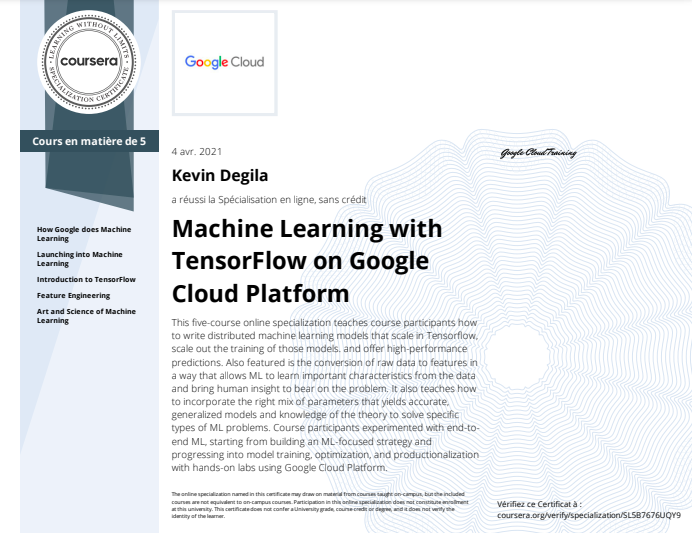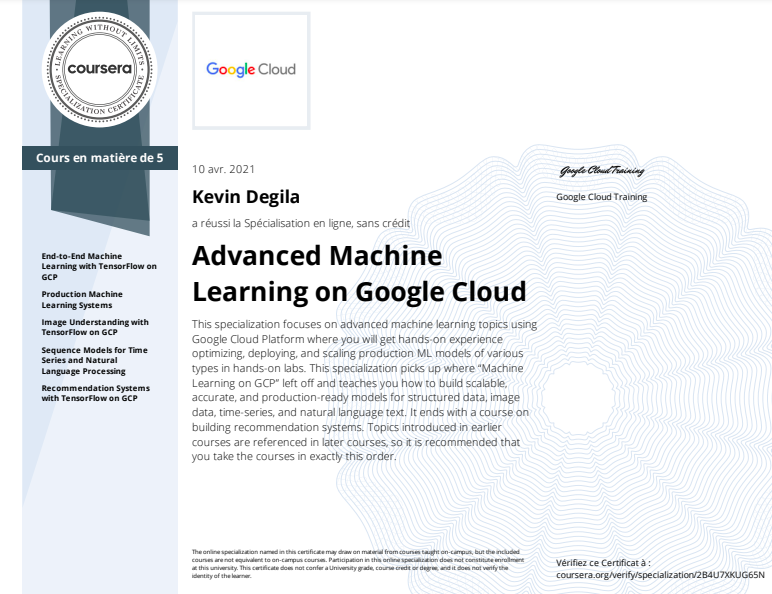How I prepared for and passed the Google Professional Machine Learning Engineer Certification

I started writing this blog post before the exam date as a way to organize my resources. If you’re reading this, It means that I succeeded and I’m now a certified Professional Machine Learning Engineer. In this blog post, I’ll walk you through my learning plan and resources, and some tips about the exam.
What is the Google Professional Machine Learning Engineer Certification#
I can’t say it better than Google. So I will just quote their definition :
A Professional Machine Learning Engineer designs, builds, and productionizes ML models to solve business challenges using Google Cloud technologies and knowledge of proven ML models and techniques. The ML Engineer considers responsible AI throughout the ML development process, and collaborates closely with other job roles to ensure long-term success of models. The ML Engineer should be proficient in all aspects of model architecture, data pipeline interaction, and metrics interpretation. The ML Engineer needs familiarity with foundational concepts of application development, infrastructure management, data engineering, and data governance. Through an understanding of training, retraining, deploying, scheduling, monitoring, and improving models, the ML Engineer designs and creates scalable solutions for optimal performance.
The Professional Machine Learning Engineer exam assesses your ability to:
- Frame ML problems
- Architect ML solutions
- Design data preparation and processing systems
- Develop ML models
- Automate & orchestrate ML pipelines
- Monitor, optimize, and maintain ML solutions
Why did I decide to take this exam ?#
I’ve been working as a Machine Learning Engineer for 2 years now. In those 2 years, I’ve been confronted with the challenges of deploying and maintaining ML models in production. How do you monitor your model in production ? When to retrain ? How do you test and automate your pipeline to facilitate reproductibility and collaboration ? You’re already thinking about MLOps and you’re right. Those are the challenges adressed by MLOps.
Also our dataset at work keep growing and soon enough, It will be impossible to train models on it locally. Enter the cloud. I’ve been using Google Cloud for a while now, the compute, storage and streaming offerings. But you can do so much more. How is Google able to train models on Terrabytes of data ? How is training distributed ? How do you process data at that scale ?
Those were my questions and the exam was the perfect opportunity to learn those skills. And spoiler alert, It wasn’t easy but I learned a lot … Not only the theory but practical skills as well. How ?
Learning Plan : Start here#
I’ve spent a lot of time reading blog posts written by those who took the test before me. I’ve also read the details of the recommended learning path by Google. Here is the plan I created for myself based on all the reading I did.
Watch the webinar to learn more about the exam format. You’ll see Lak Lakshmanan (Head of Data Analytics and AI Solutions Google Cloud) and Di Wu (VP of Data Science Jellyfish) go through some sample questions.
Read the Exam Guide to know what you’ll have to learn to pass the exam. It’s a long list and you’ll have to come back to it from time to time.
15 sample questions to familiarize yourself with the format of exam questions and the kind of topics covered in the exam. Here you can have an idea about your current level. There are some links attached to the answers. Read them and come back to these questions till you have all the right answers.
This is the part where you need to register for the exam and choose an exam date. This is important. Having a deadline can help speed up your learning. Plus you’ll need to create a biometric profile in the Webassessor in advanced. Don’t wait till your exam date.
-
Machine Learning Crash course If you’re an experienced Machine Learning practitioner, you already know everything in this course. I would suggest doing the Programming Exercices. If you get everything right, you can continue. If not, go through the course
At this point, you’ve learned interesting Machine learning concepts. You can go to the Cloud Part. Go through the courses in the Google recommended Learning Path .
In those courses, you’ll learn how to do Machine learning on Google cloud, how to architect ML solutions, ML APIs, AI Platform, MLOps and more. Yes, it’s a lot of learning content and time consuming, but you’ll have fun with the labs in Coursera. Don’t forget, the goal is not to just have a certification, but to gain valuable skills. For some motivation,here you can see my certifications of completion for the 2 specializations in the learning path.


Also Coursera just launched a specialization with all the courses recommended to pass the certification. Check it out here .
The labs !!! The labs !!! I learn so much with the labs. With qwiklabs, you’re given a student cloud account for an hour or more with detailed instructions. You can have access to them for free for a month. Do as much as you can. Check my Qwiklab profile here
- Data Science on Google Cloud Platform Book by Valliappa Lakshmanan

I can’t describe the feeling after finishing this book. It was like gaining 3 years worth of work experience in a month. Check the table of contents here . If you decide to read the book, I would suggest that you also do the corresponding labs on qwiklabs after each chapter.
In the book, you’ll go through a practical Machine learning use case: from Data Ingestion to Model deployment. Everything you’ve already learned about Data engineering on GCP and AI Platform will click better when you’ll see how they are used in a real use case.
- Machine Learning Design Patterns

Valliappa Lakshmanan is also a co-author of this book. I could have made this article shorter by saying you just need to go through every book and course made by Lak 😅.
In this book, you’ll learn about practical ML design patterns and MLOps. Once gain, things will click better after reading this book. Read the table of contents here
Ouf 🤯 😵, that was a lot of learning. I told you, It is not about just being certified. I wanted to actually be able to do Machine Learning at scale and apply MLOps best practices.
At this point, you’re ready but I can finish the learning path without recommending The Google cloud documentation. Everything is there. But if you’re lazy, just read theses articles on the Google cloud blog:
- Architecture for MLOps using TFX, Kubeflow Pipelines, and Cloud Build
- MLOps Continuous Delivery and Automation Pipelines in Machine Learning
- Best Practices for performance and cost optimization for machine learning
- Rules of ML
That’s it for my learning plan. I’m sure you can succeed in the exam without going through the complete list but I like to be overprepared.
The Exam#
Okay, you’re ready. It’s exam day. I was quite both stressed and excited on the exam day. I took the online proctored exam, so I made sure my phone was off, no noise in my work environment, no paper, no pen, no anything other than my laptop. Ten minutes before the exam, I launched the exam software and had to show my room using the webcam and also show my laptop using a miror. Here is what my setup looked like:

After that, the process was quite straigthforward. I had 60 Multiple choices questions and 2 hours to finish them. You can mark some questions for review later, but don’t mark too many. You won’t have the time to go throw them all. I had only 10 questions marked for review but end up not changing any of my answers. Some questions were really easy but some required a minute or 2 of thinking. At the end of the exam, I got the results straight away but waited a week before getting the email and the certification from Google.
Few tips for the Exam#
- Make sure you know everything about AI Platform.
- If you need to stream Data, Pub/Sub and Dataflow are probably involved
- Pay attention to the requirements of the situation. Do we want to train a model the quickest way ? Do we want fast inference ? Batch or online predictions ?
- If your data is in BigQuery, BigQueryML is probably the easiest way to train a first model
- Know your metrics, when to use them and how to improve them as well
- Think about ML APIs, AutoML, BigQueryML, AI Platform built-in algorithms before going for a custom training
- Understand AI Explanations techniques
Additional resources#
These blog posts really helped me create my learning plan and know what to expect on the exam day. I can’t thank the authors enough. Here is a non exhaustive list :
-
20 Days to Google Cloud Professional Machine Learning Engineer Exam (BETA)
-
Prepare your certification as Google Professional Machine Learning Engineer
-
My GCP Professional ML Engineer Certification Journey and Guide
And everything here
If you’re on your journey to be certified, Good luck and don’t hesistate to reach out on Twitter if you have any question.